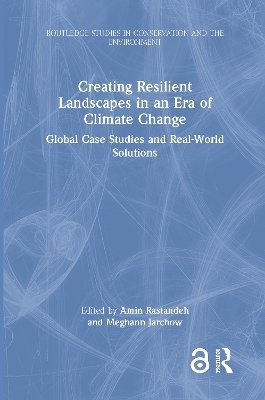
Creating Resilient Landscapes in an Era of Climate Change
Routledge (Verlag)
978-1-032-21037-7 (ISBN)
From across six continents, this book presents fifteen case studies of differing sociocultural, economic, and biophysical backgrounds that showcase opportunities and limitations for creating resilient landscapes throughout the world. The potential to create socio-ecological resilience is examined across a wide range of landscapes, including agricultural, island, forest, coastal, and urban landscapes, across sixteen countries: Argentina, Australia, Brazil, Denmark, Finland, Greece, Guatemala, Japan, Mexico, Norway, Samoa, South Africa, the United States, Turkey, Uruguay, and Vanuatu. Chapters discuss current and future issues around creating a sustainable food system, conserving biodiversity, and climate change adaptation and resilience, with green infrastructure, nature-based architecture, green-tech, and ecosystem services as just a few of the approaches discussed. The book emphasizes solution-oriented approaches for an "ecological hope" that can support landscape resiliency in this chaotic era, and the chapters consider the importance of envisioning an unpredictable future with numerous uncertainties. In this context, the key focus is on how we all can tackle the intertwined impacts of climate change, biodiversity loss, and large-scale land-cover conversion in urban and non-urban landscapes, with particular attention to the concept of landscape resiliency. The volume provides that much-needed link between theory and practice to deliver forward-thinking, practical solutions.
This book will be of great interest to students, researchers, practitioners and policymakers who are interested in the complex relationship between landscapes, climate change, biodiversity loss, and land-based conversion at local, national and global scales.
Amin Rastandeh is a landscape analyst, with experience in the United States, New Zealand, and Iran, working on human-environmental interactions and climate change in evolving multifunctional landscapes. He worked as a postdoctoral researcher in the Department of Sustainability and Environment at the University of South Dakota, United States. He specializes in multi-scale design and management of landscapes for safeguarding biodiversity and human communities in the face of climate change. Meghann Jarchow is chair and associate professor in the Department of Sustainability and Environment at the University of South Dakota, United States. Her expertise includes taking a place-based approach to working toward greater sustainability including serving as chair of Greening Vermillion, president of Spirit Mound Historic Prairie, and board Member of EcoSun Prairie Farms.
1. Landscape Resilience in the Face of Climate Change: A Call to Transition from Despair to Hope 2. Multifunctional Land Consolidations in Denmark: Rethinking the Pattern of Landownership to Create Resilient Future Landscapes 3. Resilient Food Production – Resilient Landscapes: The Role of Heterogeneity and Scale 4. Re-Developing Relationships with Landscapes for Food, Water, and Energy Self-Sufficiency in Southeastern South Dakota, USA 5. A Social Perennial Vision for the North American Great Plains Rooted in the Resilience of a Natural System-Inspired Agriculture 6. Resilient Food Systems in the Context of Intersectional Discrimination: Successful Strategies of Women and Indigenous Peoples in Mesoamerica 7. Improved Grazing Management for Resilience and Ecosystem Services: The Case of Beef Production Systems on the Campos Grasslands of South America 8. How Does Gardening Reduce Vulnerability for the Urban Poor in Small Island Developing States? A Case Study of Port Vila, Vanuatu 9. The Case of the Khayelitsha Wetlands Park, South Africa: Securing Biodiversity and Social Benefits from Urban Greenspace 10. Green Infrastructure in Hornsby NSW: A Collaborative Method Toward Landscape Resilience 11. Satoyama Landscapes: Creating Resilient Socio-Ecological Production Landscapes in Japan 12. Shifting Concepts of Urban Landscape in Helsinki: From Primary Forests to High Tech Nature-Based Solutions 13. Traditional Nature-Based Architecture and Landscape Design: Lessons from Samoa and Wider Oceania 14. Estimation of Spatiotemporal Variation in Potential Ecosystem Services: A Case Study of Aydın, Turkey 15. Scenario Based Thinking to Negotiate Coastal Squeeze of Ecosystems: Green, Blue, Grey and Hybrid Infrastructures for Climate Adaptation and Resilience 16. Utilization of Forest Landscapes for Biodiversity Conservation in a Mediterranean Ecosystem: A Case Study of Greece 17. Creating Resilient Landscapes: From a Hopeful Vision to a Long-Lasting Existence
| Erscheinungsdatum | 12.12.2022 |
|---|---|
| Reihe/Serie | Routledge Studies in Conservation and the Environment |
| Zusatzinfo | 8 Tables, black and white; 13 Line drawings, black and white; 54 Halftones, black and white; 67 Illustrations, black and white |
| Verlagsort | London |
| Sprache | englisch |
| Maße | 156 x 234 mm |
| Gewicht | 703 g |
| Themenwelt | Naturwissenschaften ► Biologie ► Ökologie / Naturschutz |
| Technik ► Architektur | |
| Weitere Fachgebiete ► Land- / Forstwirtschaft / Fischerei | |
| ISBN-10 | 1-032-21037-0 / 1032210370 |
| ISBN-13 | 978-1-032-21037-7 / 9781032210377 |
| Zustand | Neuware |
| Haben Sie eine Frage zum Produkt? |
aus dem Bereich


